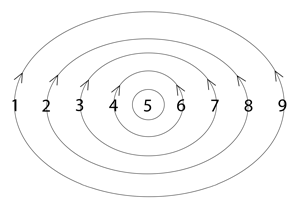present
1-6-7
Conventional Understanding
Conventionally, we view “present” as either a moment in time between past and future or a state of attentive awareness of immediate experience. This understanding positions us as separate observers witnessing events happening “to us” or “around us.” We’re taught to “be present” as if presence were a technique to apply rather than a natural state of being. This fragmented view creates artificial separation between experiencing and reflection, leading to the common belief that thinking pulls us away from presence.
Resonant Understanding
Word Cosmology reveals “present” carrying a 1-6-7 resonance pattern. This pattern shows “present” functioning at Position 7 in the Reflective Triad, where we recognize that experience unfolds within a mental universe rather than a physical one. The pattern begins with initial impulse (1), connects to manifestation (6), and reveals the reflective nature of experience (7).
Like a cinema where images appear real yet are projections of light, “present” reveals that what we experience as “now” unfolds within a mental field rather than a solid physical world. This isn’t about observing reality from outside but recognizing our participation within this mental projection. The table shows this connection through related expressions like “individuate desire” and “self-discipline” that share this same resonance pattern.
Expressions Spectrum Analysis
In balanced expression, this resonance pattern appears as “present,” “a relationship with form,” “free,” “align,” and “acceptance of feelings,” revealing the natural flow of being where human focal points relate to form without becoming trapped in it. These expressions demonstrate neither grasping nor avoiding, but rather a fluid relationship with the unfolding forms in the mental cinema. This balance allows for participating in form while recognizing its mental nature.
When over-modulated, expressions include “human doing,” “need to control,” “charm,” “chasing,” and “grasp,” revealing the distortion that occurs when a focal point attempts to seize or direct the unfolding mental projection. These expressions demonstrate the tension and restriction that arise when trying to force or manipulate what naturally unfolds within the mental cinema, creating the illusion of a separate doer attempting to control form.
Under-modulated expressions such as “afraid of being real,” “dark,” “reject,” “withdraw,” and “wanting” demonstrate a retreat from participation in the mental cinema, where the focal point pulls away from engaging with form. These expressions reveal the contraction and diminishment that occur when avoiding relationship with the unfolding mental projection, creating shadows where the light of expression could naturally flow.
Beyond these modulation patterns, uncategorized expressions like “mental universe,” “simulation,” “spectral absorption,” and “right brain” point to the fundamental nature of the arena in which all experience unfolds. These terms reveal “present” as not merely a state of awareness but the entire field of the mental cinema itself through which all apparent forms appear.
Russell’s Cosmogony Connection
Walter Russell’s cosmogony illuminates the “present” pattern through his description of the reflective nature of reality. Based on the project knowledge, Russell describes a universe of two-way motion where all manifestation involves rhythmic balanced interchange between compression and radiation.
As found in the project knowledge, Russell states: “Life is eternal. There is no death. Life is but simulated in matter by polarization-depolarization sequences as all idea of Mind is but simulated in thought-waves of moving matter.” This directly connects to the “simulation” concept in the uncategorized column, revealing that what appears as physical reality is a simulation created through wave interactions.
Russell’s description of the “zero point” from which all motion extends and to which it returns illuminates Position 7’s reflective function. In this understanding, the “present” at Position 7 reveals the point where we can recognize the mental nature of experience – where we participate in what Russell calls the “rhythmic balanced interchange” that structures all reality.
These principles align with the uncategorized expressions in the “present” table – the “simulation,” “mental universe,” and “geometric relationship” that point to the mental, wave-based nature of experienced reality. Position 7 is where the focal point can recognize this fundamental structure of experience.
Practical Implications
This understanding transforms our relationship with “present” from a technique to apply to a recognition of the nature of unfolding itself. Rather than trying to “be present” through effort or control, we can recognize that all experience unfolds within the mental cinema, with human focal points serving as unique perspectives within this unfolding.
Practically, this means shifting from trying to “do presence” to allowing natural alignment with the two-way motion of unfolding and refolding. The balanced expressions suggest approaches like “acceptance of feelings,” “appreciating self reflection,” and “discernment” that allow for participation without grasping or avoiding.
This perspective challenges dominant narratives about reality itself, revealing that what we call the “physical world” unfolds as patterns within a mental cinema. This doesn’t diminish the importance of form but places it within a larger context of unfolding where human focal points neither control nor are controlled by the forms appearing in the mental cinema.
By recognizing the 1-6-7 pattern of “present,” we liberate ourselves from both the drive to control form and the tendency to withdraw from it. Instead, we can participate in the natural unfolding, recognizing that “now” is not a moment in time but the continuous unfolding of form (6-1-7) within the mental cinema, while “present” (1-6-7) maintains connection to the initial creative impulse that animates all form.
Walter Russell’s quotes are from his book, “A New Concept of the Universe”.


